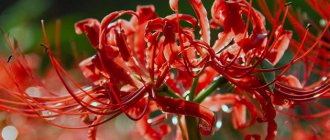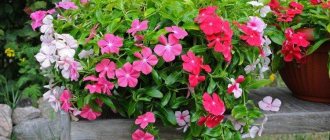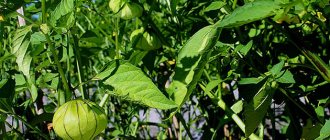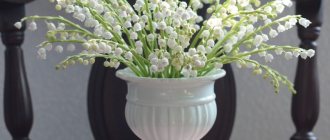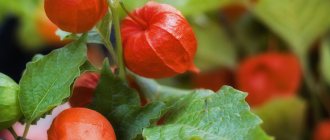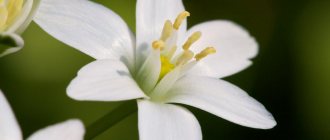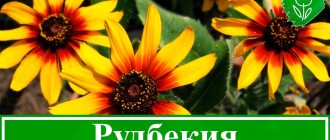There is a belief that Kufeya reconciles and unites people. This may be why the flower is often found in business centers and offices. And if you put a magic bush at home, then household members will argue less and stop swearing.
Author of the article
Anna Dmitrieva
Gardener with 15 years of experience.
Description
Translated from Greek, kufeya means “crooked”; it is believed that the plant got this name because of the fruits, which have a curved shape. Kufeya is a compact ornamental plant. It owes this to its strong stem, to which many small leaves are attached; they have an oblong and solid shape, and their tops are pointed towards the edge. The flowering period of kufei is considered to be the beginning of the spring season, and it lasts until mid-autumn. The gaps between the leaves are filled with gorgeous inflorescences, which give a special charm to the plant. Basically, the flower cup consists of 6 petals and has a porous structure. The color range of flowers is quite varied. Most varieties of kufei are not replete with contrasting shades, but, on the contrary, are painted in delicate tones.
The culture is ideal for planting in open ground and looks good as a houseplant. Kufeya is usually cultivated as an annual plant when it comes to planting in the garden. The plant can survive the winter season only if it grows in the southern part of Russia. Some varieties of flowers can withstand up to 12 degrees below zero. It can be grown indoors for several years. The main difficulty in growing such flowers in our area seems to be the heat-loving nature of kufei. It is best to grow them in flowerpots or any other containers.
In the warm season, such a plant can be used to decorate a garden or balcony, and with the onset of cold weather, it can be placed again in a warm indoor environment.
Botanical description
Cuphea or Japanese myrtle is an annual and perennial herbaceous plant, as well as shrubs, belonging to the family Derbennikov. In the natural environment, these interesting and unusual plants are common in temperate, tropical and subtropical climate zones of America (southern and central parts).
The name of the plant comes from the Greek word “kyphos”, which means “crooked, bent”. After the end of flowering, curved fruits are set; most likely, the name of the plant was given due to this.
Kufei has a compact appearance. The stems are erect, dotted with small oblong leaves with entire edges and sharp tips.
When does kufeya bloom?
The flowering period of kufei is long: it begins in early spring and lasts until October. There are as many inflorescences as there are leaves, but they do not compete with each other, but only complement each other, the bush becomes exquisite and very elegant.
The flowers are tubular in shape, with six petals in almost all species (the upper two petals are usually larger in size). Modest flowers can be white, pink, lilac, red. It’s as if nature specially created kufeya for lovers of meditation - the plant does not have huge inflorescences or “screaming” forms; admiring the plant, the soul is filled with peace and tranquility. By the way, the stems of the plant are a little sticky; if you plant tall bushes around the perimeter of the plot, you will protect your yard from the unceremonious invasion of your neighbor’s pets.
Frost resistance of kufei
Kufeya is simultaneously among the indoor and garden plants. In the conditions of central Russia, annual species and varieties are grown seasonally in open ground, and perennials are cultivated as indoor plants. Flowerpots with flowering bushes become decorations for the garden, veranda, and balcony during the warm season. In October, bring the containers with the plant into a cool but closed room, and when frost sets in, return them to their usual place (in the room). Kufeya is capable of wintering in open ground only in the southern regions of the country. The most frost-resistant varieties can withstand a maximum of 12°C below zero.
Even in its homeland, kufeya became popular in gardening some 15 years ago. In Arizona, in the late 80s, active work began on breeding new interspecific hybrids, but the results of their work have not yet reached European countries. Growing kufeya is not difficult, but due to its heat-loving nature, it has its own difficulties.
Types and popular varieties
We present to your attention a list of the most popular varieties of kufei.
Kufeya issopolis
The plant came to us from distant Mexico. Due to its natural habitat, kufei is a very heat-loving plant. The advantage is that rain does not pose much of a threat to the plant. Kufeya also easily withstands gusts of wind. This ornamental crop is quite compact in shape and is usually cultivated in the form of small bushes.
The height of representatives of the issopolous kufei does not exceed 50 centimeters. The shoots are very branched and twisting. Usually grown indoors. The leaves on the stems are placed in the opposite order and appear in the form of small petioles. The lanceolate leaves are green. The flowers are small in size and grow in the axillary part of the leaves. The petals are painted in various shades of delicate tones.
Kufeya fiery red
Representatives of this species can reach a maximum height of 40 centimeters. The lanceolate leaves of the shrub have an oblong shape, can reach 5 centimeters in length, and their width can be 2-3 centimeters. In the arrangement of leaves on the shoots, the plant has the same order as the previous variety of kufei. They are painted dark green. The flowers of this kufei are small in size, their maximum diameter reaches three centimeters.
The plant owes its name to the color of the petals of the bud. They have a fiery red color, their curved part is painted soft purple.
Llavey
Like many representatives of this species, Laveya loves sunlight very much. It can even grow in deserts, as it does not require constant moisture and adapts perfectly to arid regions. The origin of this species is natural, unlike many other representatives of kufei. The height of the bushes can be on average 30 centimeters.
Kufei leaves have an elongated shape and are painted in dark tones of green. The edges of the leaves are decorated with small white fibers. The buds are considered large; the length of one flower can be 2.5 centimeters. The flowers are painted a rich red color, and the curved edges have a purple tint.
Kufeya Gelya
This variety belongs to the fiery red variety. External data attracts many gardeners.
In a container, this plant grows beautifully and decorates balconies, loggias, offices and other rooms. Not only in containers, but also in flower beds, the kufeya variety Gel feels great. The plant can be planted in personal plots; it is usually used to decorate borders.
Kufeya Dynamite
Kufea Dynamite is a variety of hyssopolis kufea. This bush can be easily shaped by pruning to create the desired shape. For this reason, in addition to growing in containers, they prefer to plant the plant in open ground.
Abundant flowering in the warm season can truly decorate any, even the most unattractive, area. The shrub prefers warm weather, but winds and rains are not particularly scary for it.
Water kufeya
An aquarium plant, its maintenance is even simpler.
Micropetal
The height of this type of kufei is 30-40 cm. It has bright green narrow leaves and flowers of a red-yellow hue. In the West, the name of this plant is translated as “candy corn . And this is not surprising, because the flowers resemble the famous Candy Corn candies, which are shaped like corn kernels.
If the plant is planted in open ground, it will reach an average height of 1 meter. Thanks to its bright red large flowers and strong shoots, the micropetal kufeya looks quite impressive in the garden.
Pale
The variety may have flower corollas of white, pink or lilac. Plant the plant in the most wind-protected place in the garden or on the balcony if it faces south.
Kufeya prostrate
A very beautiful plant. But, alas, it is somewhat less common. For some unknown reason, seeds of this species are rarely found on sale. But if you are lucky enough to find them, you can count on a good and friendly similarity. Pretty soon you will get a nice small (up to half a meter tall) bush with a lush green crown, dotted with white, lilac or purple flowers.
Lanceolate
The bush reaches a height of 0.9 meters. The flowers are beautifully tubular in shape and dark purple in color. Flowering continues in summer and autumn. Reproduction in kufei occurs through seeds. In the photo below is the Kufeya Lanceolate variety:
Sriracha
Typically, these representatives are colored in delicate colors, such as pink, raspberry or lilac. Representatives of this variety love high temperatures. Hybrids of such kufei are considered quite young varieties. Grows effectively at temperatures above +20 degrees. But cool summers won't be a big problem for flowers. The size of the bushes to some extent depends on the growing area, but on average they can reach 30 centimeters in height.
Unlike its relatives, the appearance of the plant is not curved; on the contrary, this kufeya is erect.
Peculiarities
The beauty of Kufei attracts the attention of amateur flower growers and landscape designers around the world. Over the past decade, the culture has become widely known and has received many bright, decorative hybrids.
Among the positive qualities of Kufei, the following are most often mentioned:
- The ability to use a flower to form different compositions in flower beds or decorate borders.
- The versatility of the plant: the ability of flowers to grow in an open flower bed in summer and in pots in winter.
- Good rooting of stems, which provides abundant material for propagation.
- Ability to bloom for a long time.
Among the disadvantages of kufei, the difficulty in maintaining the desired humidity balance is sometimes cited. Insufficient watering is harmful to the bushes, and excessive watering provokes fungal infections. Therefore, for kufei it is necessary to arrange a drainage layer when planting and additionally lighten the soil by adding sand, sphagnum, and peat chips.
Kufeya looks great in single plantings or against the background of other plants. Tall forms serve as an excellent background for bright, low flowers. Planting seedlings and caring for this tropical beauty in the open ground differs little from the usual garden flowers, and its unusual, discreet beauty enlivens flower beds, balconies, and terraces from early summer until late autumn.
Kufeya care at home
Soil for growing in a pot
Peat, leaf humus, turf soil. Add coarse sand to improve drainage.
Lighting
In order for a bush to grow normally and bloom beautifully, it needs proper lighting. If there is insufficient light, the kufei shoots will become thinner and the plant will stop blooming.
The flower will feel best on a southwest or southeast window . If you place it on the south side, the rim of the leaves will acquire a fiery red hue. To prevent this, the plant needs to be shaded from the bright rays of the sun during the day.
Humidity and watering
When growing a plant in a room, it requires high air humidity - 65% or more. This helps the bush feel like it’s in the tropics, and also prevents possible diseases and pest damage. To create the desired atmosphere in a room, the humidity must be increased artificially.
To do this, the kufeya must be sprayed. In summer, this is done every other day, and after spraying, the pot with the bush must be shaded from the bright sun in order to prevent burns.
During the heating season, the flower should be placed as far as possible from the radiator , placing it on a tray with wet pebbles. You need to place an open bowl of water nearby. When caring for kufeya at home, it is important to constantly check the soil - it should not dry out. In summer, the flower is watered abundantly every 4 days, making sure that the remaining moisture pours out through the drainage holes.
It is worth remembering that stagnation of moisture can cause rotting of the rhizome. This can be prevented by properly making a drainage layer at the bottom of the pot and adding components to the soil that can loosen it (brick chips, vermiculite and others). In autumn, the number of waterings is reduced, and in winter, watering is done no more than once every 10 days.
For irrigation, always use settled warm water. To retain moisture, the area around the roots is mulched with sphagnum or coconut substrate.
Spraying
It can tolerate fairly dry air, but when central heating is turned on in the premises, it is better to increase the air humidity. Place the plant on a tray with a grid, the bottom of which is filled with water. Make sure that the bottom of the pot does not come into contact with water. Use a room humidifier or mist the plant's leaves with soft water at room temperature in the morning. Keep the plant away from doorways where it may be exposed to cold drafts.
Temperature
If kufeya grows in a room, you need to remember that it is heat-loving. In order for the bush to always look beautiful and bloom for a long time, it is necessary to maintain the correct temperature regime. In cold weather, you should not allow the temperature to drop below +12°C, but the plant feels best at 18°C. In summer, the optimal temperature for kufei is +23-25°C.
If the plant succumbs to temperature changes or frequent drafts, the kufeya will begin to quickly lose leaves.
In summer, the flower is taken out into the garden or placed on the balcony ( it is important to protect the kufeya from the wind ). In the room, place the container with kufeya away from the air conditioner and an open window.
Transfer
Young bushes need to be replanted every spring, while older ones need to be replanted as needed (about once every 2-3 years, when the roots completely entangle the clod of earth). The main thing is to choose the right pot for the flower, which is the key to long and abundant flowering. When replanting, the size of the pot is increased by 3 cm each time , and it is believed that the maximum volume of the container should be 25 cm.
If the pot of the kufei is slightly cramped, it blooms more luxuriantly.
At the bottom of the pot, be sure to make containers for drainage of water - this will help avoid rotting of the root system.
A layer of drainage (preferably thick) is placed at the bottom of a container suitable for replanting, on top of which fresh soil mixture is poured. Place the plant there and gradually add soil to the rhizome, pressing it lightly. Then the kufeya should be watered with settled water and covered with soil again, trying not to make the growing point deeper. After transplantation, the bush is shaded for 3-5 days so that it adapts to the changed conditions. The first feeding can be done after 14 days.
Top dressing
Periodic feeding of the bush contributes to the beautiful flowering of kufei. To do this, once every 14 days, from spring to autumn, use a complex fertilizer intended for house flowers, which contains potassium and phosphorus.
The fertilizer must be diluted according to the instructions and then applied after watering. Then the kufeya needs to be shaded for 1-2 days.
Rest period
To recuperate after a long flowering period, the plant requires a period of rest, lasting from early November to early March. During this time, the pot of kufeya should be kept in the cold and rarely watered.
The plant cannot be fed during this period, as the kufeya will completely exhaust its strength.
Pruning kufei
Pruning must be done every spring. At this time, it will be possible to give the crown a good shape and the desired size.
- The fiery red kufeya needs to be pruned so as to shorten only the long branched shoots.
- Kufeya hyssopolis will have to be shaped much more carefully to make an attractive crown.
In the last days of March, 2/3 of the shoots should be removed, this is how growth and vegetation are stimulated.
Formed kufei bush
Basic rules of care
The optimal summer ambient temperature for growing kufei is between 18 and 25 degrees. In winter, perennial varieties require lower temperatures, from 12 to 15 degrees. The plant successfully tolerates colder conditions, but in this case it will bloom much later. There are several frost-resistant varieties that can withstand cold temperatures down to minus 12 degrees.
Kufeya develops well only in well-moistened soil. Water it generously, at least two to three times a week, and daily on very hot days. It is especially important to monitor soil moisture during the flowering period. If there is a lack of moisture, there will be fewer flowers on the bush and they will not be lush. The soil must be saturated with moisture so that the entire root system of the plant is in a moist environment. At the same time, the gel does not tolerate stagnation of water around its roots, which is saved by drainage.
In winter, reduce watering by three times. In any season, systematically spray the leaves and flowers of the cigarette tree with water. Its temperature should be the same as the ambient temperature.
Kufeya: planting and care in open ground
When it comes to planting in the garden, in Russia kufeya is usually cultivated as an annual plant. Because the roots can survive the winter season only if the temperature does not fall below -12 degrees. It is clear that the conditions of the Moscow region are in no way suitable for planting perennial varieties - winter will destroy the roots. But in the south of the country it is quite possible to try planting kufeya in the ground for several years.
- Choosing a landing site
When planning to grow kufeya in the garden, you need to choose an open, well-lit area. Unlike other ornamental crops, this flower tolerates direct sunlight.
- Planting in open ground
The plant is planted by transferring it into pre-prepared holes (humus must be added to them and dug well).
Allowable distance between individual bushes: at least 30 centimeters.
- Watering garden kufei
You need to make sure that the soil does not dry out.
The plant likes daily evening watering, when the sun is no longer hot, but has not yet set.
Attention! If you water flower bushes after sunset, rot may appear.
- Need for fertilizers
If, when planting a plant in open ground, organic matter was added to the soil, then fertilizing may no longer be carried out. If, for some reason, the planting holes were not properly prepared, then fertilizer will need to be added for abundant flowering.
A couple of weeks after planting, they are fed with nitrogen fertilizers. When the buds begin to form, it would be good to add phosphorus-potassium substances.
Preparation of planting material and propagation
Kufeya can be propagated in several ways, the simplest of which is cuttings. Other vegetative methods are also effective. The crop is grown less frequently by seeds, since germination is more labor-intensive.
Propagation by seeds
Kufeya (planting and care in open ground is possible only with good heating of the soil and air) is grown through seedlings for early flowering in flowerbeds. The optimal time for preparing seeds is early April. Flowering of kufei occurs 3 months after sowing, so later seedlings will produce buds no earlier than the end of July.
Kufeya is perennial. Planting and caring for the plant further.
Sequence of work:
- Prepare small planting cups. Drainage holes are made in the bottom.
- The substrate for kufei germination is prepared from leaf or turf soil, adding peat and coarse river sand.
- The homemade mixture must be disinfected (heated or frozen).
- Fill the glasses with the substrate without compaction. The soil should remain loose.
- Small kufei seeds are laid out on the surface: 2-3 seeds per glass.
- The top of the crops is not sprinkled with soil, but lightly pressed with the palm of your hand.
- The surface is generously sprayed and covered with a transparent film for a greenhouse effect.
At a temperature of +20...+22 °C, seedlings appear within a week. From this point on, the shelter can be removed and the kufei sprouts can be placed on a sunny windowsill.
Kufeya can be sown directly in open ground, but since the germination rate of the seeds is low, sowing for seedlings followed by replanting is more often used. Seedlings are ready to be moved to an open flower bed as soon as 2-3 leaves appear.
Rooting cuttings
When pruning flowering kufei bushes, you can get a lot of material for propagation. Fresh cuttings take root well and quickly begin to bloom. Autumn and spring cuttings give good results.
Sequence of work:
- The tops of the shoots obtained by pruning are cleared of the lower leaves.
- Dip the cuttings in a root formation stimulator.
- Bury the shoots into a loose substrate.
- The rooting substrate is prepared in the same way as for seedlings.
- Containers will need to be at least 15 cm deep.
- After planting, the cuttings are watered and covered with cut plastic bottles.
Improvised greenhouses are ventilated daily and the soil is moistened as needed. The signal that the kufeya can be replanted is the appearance of new leaves. But gardeners prefer to grow cuttings in one container for at least six months. This way you can get strong, abundantly flowering plants in one season.
Reproduction by layering
The method is considered the simplest and always gives a guaranteed result. For such propagation, any suitable stem is chosen from creeping varieties. In erect kufei, the stem can not be bent, but rooted in a straight position.
Rooting cuttings:
- An incision is made on the stem at a convenient height.
- The flexible shoot is pressed to the ground and hilled up; for potted crops, a small cup of soil is used.
- The standing branch at the cut site is wrapped with damp sphagnum moss, and on top with polyethylene.
When roots appear, the branch can be separated from the mother plant and the young kufeya can be planted separately. Typically, the formation of roots takes no more than 10 days, which is much less than with other propagation methods.
Dividing the bush
A simple propagation method suitable for perennial kufei bushes.
To get several bushes from one old one, follow these simple recommendations:
- Dig the kufeya out of the ground.
- Shorten all shoots to 10 cm.
- Break or cut the rhizome into several parts.
- Each division must have at least one strong, healthy stem.
Each part of the bush is dipped in a fungicide solution, and then immediately planted in moist soil. Transplantation with division is most often carried out in the spring. This way you can rejuvenate an adult kufei bush and get several flowering, strong plants.
How does kufeya reproduce?
Kufeya propagates using cuttings and seeds. If any of the propagation methods has produced a strong and healthy plant, it can be safely planted in open ground.
Germination of seeds
Instructions for sowing seeds:
- The seeds of the plant are stiff and have poor germination. The seed material is laid out on the soil surface. You don’t need to cover them with soil, you can just press them a little into the ground.
- The containers must be covered with film and placed in a warm place.
- Abundant but infrequent watering is carried out.
- Picking should be carried out after the appearance of the fifth leaf.
Rooting cuttings
It is better to cut cuttings for propagation in late spring. They can be successfully rooted using phytolamps.
The main thing is that there are at least 2 nodes on the cutting. To begin with, the cuttings are planted in sand and the container is covered with film. Don't forget about watering.
After rooting, the cuttings can be safely planted in different containers.
Air layering
Those varieties of kufei that have air layering can be propagated with their help. To do this, it is important to cut off the desired area of the shoot, treat it, moisten it and wait until roots appear in this place.
The cuttings are cut at a distance of 1.5 cm below the cuff and planted in the substrate.
For reference: this method of propagation is practically not used for kufei.
Reproduction of the Kufeya plant
Propagated by both cuttings and seeds.
Cuttings are the most common way to propagate kufeya. At the end of May, when the temperature has already settled, cuttings are taken from the plant. Young shoots should be selected.
The top of the shoot is cut off at an oblique angle with a sharp knife. The blanks are placed in a container with water for germination. After a week, the petioles will give roots, which are transplanted into a pot, 3-4 pieces per hole. The first leaves are pinched.
Important! Kufei seeds are planted from April to May.
To plant, the seeds are first germinated. The hatched sprouts are planted in a small pot or plastic cup. The strengthened seedlings are transplanted into a larger pot, at least 11 centimeters.
Pests, diseases and possible problems
- Kufeya can be affected by aphids and spider mites. Treat it with an insecticide.
- The plant may rot if it is systematically overwatered.
- Leaves may fall if the kufeya is in a draft.
- Gray spots on the leaves may indicate the appearance of a fungus or gray rot - cut off the affected parts and treat the plant with a systemic fungicide.
- Kufeya is prone to chlorosis - if its leaves turn yellow but remain elastic, pour it with iron chelate, or even better, spray it over the leaves.
Difficulties in growing kufei
When growing this plant, problems can arise when the soil is flooded and there is high humidity, then dark spots appear on the stems and leaves, which are caused by gray rot or various fungal diseases. If such symptoms are noticed, then treatment with fungicidal preparations should be carried out. Among the pests that plague kufei are whiteflies, spider mites or aphids. If a pest is detected, the foliage should be sprayed with insecticidal agents. If the plant is exposed to a draft, this may cause leaf loss.
Some tips
- Fertilize the soil with organic fertilizers. In this case, the kufeya will reach its maximum size at the beginning of summer.
- Don't be afraid to trim your bushes regularly. This only makes it thicker and more magnificent. You can prune kufeya at any time of the year. Designers successfully use this and form intricate plots from the crowns of bushes.
- Plant the sprouts at a distance of at least 35 centimeters from each other.
- If dark spots suddenly appear on the leaves, then know that the roots are affected by a fungus. This happens due to excessive watering or prolonged rains. In this case, the plant can be saved by using fungicidal preparations. These products can also combat powdery mildew.
- Sometimes the cigarette tree is affected by spider mites, thrips and scale insects. You can get rid of spider mites using a soap solution. After removing the insect placenta, be sure to spray the bush generously with water. A solution of potassium soap or insecticides will help against scale insects and thrips.
- And finally, a very important tip. Under no circumstances should you plant kufeya in places where there are drafts. Under their influence, the plant sheds its leaves.
Problems during cultivation
Despite the general unpretentiousness of the crop, some difficulties may arise in the process of growing it.
Dropping leaves and buds
Shedding buds and leaves is often a natural process. In some cases, the described phenomenon indicates improper conditions for keeping the flower: lack of lighting, the presence of pests, waterlogging or overdrying of the soil.
Important! Sometimes the reason for the leaves falling is due to the fact that when winter comes, the kufeya finds itself in uncomfortable temperature conditions.
Leaves turning pale
Most often, the paleness of foliage is associated with sudden temperature changes at night and daytime and drafts. A similar thing happens with seedlings that are planted in open ground too early and with flower specimens that are in open ground until late autumn.
Drying leaf tips
Drying of the leaf tips of kufei is often associated with insufficient air humidity. In some cases, certain pests also create a similar problem.
Important! The falling of the lower leaves of kufei usually does not mean anything. This is a natural process that even the most experienced gardener cannot avoid.
Pests
Kufeya most often suffers from attacks by pests such as:
- spider mite;
- scale insect;
- thrips.
When a spider mite attacks, cobwebs appear on leaves and branches. The pest is attracted to dry air in the room or area where the crop is grown. You can get rid of the insect using a solution of potassium soap; you need to thoroughly spray the flower with it. Insecticides will be no less effective.
As for the scale insect, its presence is signaled by clearly visible brown bumps on the foliage - these are insect shells. Soap solution and insecticides are also effective in combating them.
When a bush is infected with thrips, the shape of the leaves is deformed and jagged edges appear at their ends. The most effective way to combat pests is by washing the bushes under running water and then treating them with insecticides.
If you take good care of the plant, it will not get sick.
Having carefully studied the description of the culture, we can draw a completely logical conclusion that kufeya is a relatively simple plant to grow. Considering its beauty during the flowering period, it is worth seriously thinking about planting this amazing flower in your garden plot.
Interesting facts about kufei
There are tropical varieties of kufei, which are grown only to obtain oil from the seed material, whose properties are very reminiscent of coconut or palm oil. The seeds are also used as a raw material for the production of laurel acid. Many other species are cultivated both because of their highly decorative appearance, and the plant also serves as an excellent honey plant. Kufei flowers can attract hummingbirds. There is a belief that if you place this flower indoors, it can unite people. It is often recommended to place a kufeya in office premises so that it helps employees establish contacts. In the house where this delicate plant blooms, there is always a sensitive atmosphere full of goodwill.
